As of 1976, Le Pré Catelan has been part of Lenôtre, the eponymous and celebrated catering company founded by one of France’s foremost pâtissiers, Gaston Lenôtre. This former dairy farm, however, was first opened by a respected Parisian restaurateur as du Pré Catelan in 1906. To attract customers, he charged what he advertised as bourgeois prices. To his own cost though, locals did not agree with his interpretation of bourgeois whilst the moneyed Americans that pervaded Paris turned their noses up unanimously at any thing that even smelt of cheap. Therefore, he was forced to quickly sell out to the eminent Monsieur Mouriez, who already included the Café de Paris, restaurant d’Armenonville and the Abbay Thélème in his stable of iconic dining/drinking institutions. He made immediate changes, namely raising prices, which actually worked wonderfully well at attracting hordes of American tourists, but he also kept some of the restaurant’s old customs like bringing cows into the dining room to be milked by the more adventurous clientele.
In its current incarnation, Le Pré Catelan spent most of the nineties under the charge of Roland Durand, during which time Thomas Keller and Andy Needham both passed through the kitchen. In 1997, incumbent chef, Frédéric Anton took up the reins. He had prestigious pedigree. Originally from the Lorraine spa town of Contrexèville and graduating from l’École hôtelière de Gérardmer in 1978, he had his first employment at the nearby Grand Hôtel. He then went to Le Capucin Gourmand (1*) in Nancy to work under Gérard Veissière, whilst simultaneously pursuing a diploma in pastry and chocolate making. Next came Le Flambard (2*) in Lille with Robert Bardot before the big move to Gérard Boyer’s Château des Crayères (3*) in 1986. Five years on, Joël Robuchon took him on as chef de partie at his fabled restaurant Jamin (3*), where he rose to chef de cuisine by 1993, the same year that the pair moved to avenue Raymond Poincarré together. In 1996, Robuchon relinquished his stars to Michelin and his restaurant to Alain Ducasse; Anton stayed on for the next six months, supervising the transition, prior to eventually joining Le Pré Catelan.
Robuchon’s protégé, who as a youngster had no desire to cook and ‘thought it was for women’, was given full control and total freedom of this kitchen. Within two years he repaid this faith shown in him with two Michelin stars. The following year he was named Meilleur Ouvrier de France. More recently, in 2005 he was endowed with an espoir ahead of the real thing two years later. Anton has a reputation for being meticulous and precise. He is said to run a tight ship and have a keen eye for detail.
Le Pré Catelan itself is found deep within the Bois de Boulogne, a forest on the western fringes of the 16e and of Paris proper. These woodlands, which can trace their origins to the fifth century, were once filled with oak trees and a royal hunting ground. Actually, it is from Louis XIV’s Captain of the Hunt, Théophile Catelan, that the particular pré or meadow that the restaurant rests within takes its title. Le Pré Catelan, whose gardens date from the mid-eighteenth century when Baron Haussmann was hired to redesign the whole bois before it was gifted to the city, is housed in a Napoleon III style lodge and its property shares an entrance with the Jardin Shakespeare, which holds specimens of all the plants mentioned in the poet’s plays.
Arriving at Port Dauphine almost late already, I stood near the large roundabout in an attempt to attract the attentions of any passing taxis. For some time, none came. Then a few finally did appear, though these were all filled. At last, one stopped. ‘Où?’ He demanded. ‘Le Pré Catelan, s’il vous plait,’ I squeaked. ‘Jamais entendu cela,’ snapping that he had never heard of it, he drove off. It’s a restaurant, I called out, but it was too late. I started walking. I should have been at the restaurant fifteen minutes earlier, so I called to let them know I would be a little tardy, but I was still coming. On the phone, they asked me where I was, but after informing them that I was making my way there on foot, they would have none of it and ordered me back to the roundabout with instructions to wait there. I did as I was told. Within five minutes, a car had pulled up alongside, a tuxedoed and bow-tied gentleman behind the wheel, ready to whisk me away to my destination…
The main dining room sits in the larger of two small châteaux on the site. In 2007, Pierre-Yves Rochon redesigned the interior; his briefing was ‘to celebrate the natural surroundings’ of the historic building. Inside, a sprinkling of spotlights on the fifty-foot high ceiling, quadruple-decker chandelier suspended in its centre and triple-forked wall sconces that surround its sides make the space glisten. Tall mirrors, intermingled with marbled Grecian columns, rim the room. Classical capitals are intricately crafted and carved friezes follow Caran d’Ache stencilling. A fireplace is the focus of one wall, which is also bordered with lush, myrtle banquettes; opposite, a spacious bay is wrapped with tall windows. The floor, carpeted fern-green to evoke the garden outside, is filled with circular tables and dark wooden serving stations topped with black vases bearing white orchids, chrome urns and onyx pots. Grey silk curtains correspond to the grey undercloth beneath the white that has been laid over the well-sized and spaced tables. These are straightforwardly set with silver salt-and-pepper shakes; a single white rose stowed in a small, sterling boule; and monogrammed ebony and ivory Bernaudaud crockery. The room is elegant and ornate but clean, fresh and open. The mood was comfortable, merry and spirited.
I was welcomed and shown to my table by maître d’hôtel, Monsieur Jean-Jacques Chauveau. After speaking with him, I asked if he would order for me and he obliged with the Menu du Pré…
Amuse Bouche 1: Potage chaud d’oignons; crème de champignons de bois. Frothy wild mushroom cream was poured at the table into a bowl of warm, silky onion soup. Earthy, woody and sweet trompettes de mort, pieds de mouton and champignons de Paris came combined with caramelised onion. This had strong and comforting savour.
Les Pains: Baguette et pain des céréales. The bread basket brimmed with baguettes and cereal rolls made on the premises. The former were crunchy if a little dry, whilst the latter were nicely flavoured, light and seedy. Circular cakes of Pré Catelan-embossed butter, both salted and unsalted, were supplied by Pascal Beillvieve. This smooth, rich beurre was very good.
Entrée 1: La Sardine: A l’huile, Copeaux de Beurre et Pain aux Olives; Sardine et persil plat frits; Gelée de Bouillabaisse, Sauce Rouille. A triptych of pearly plates of differing size and shape were served.
First and largest of these was a big bowl bearing shallow gelée de bouillabaisse de sardines; its ritual rouille rested atop, embodied as creamy white dots of garlic and gold of saffron with interspersed silver spots of sardine. Reduced and jellified fish stock, vegetables, tomato and white wine had clean, lively savour and smooth consistency. Its topping had subtly spicy bitterness and conspicuous fishiness. The presentation of the plate was appealingly unusual, but the overriding flavour was an underlying slight harshness.
Secondly, a long rectangle featured three sardine/pilchard cross-sections, lightly breaded, filled with parsley then fried; the middle morsel bore some butter whilst a slice of lime lay on the side. The simply and well cooked fish, coated in crunchy breadcrumbs and egg, were completely greaseless. Their herb farce had crisp grassiness, whilst the lime was a competent and classic acidic counterpoint.
Last, little olive oil suffused sardines, garnished with coriander, Thai garlic, thyme, stitchwort flowers and another curl of butter, were teamed with toasted olive bread. These literally flash-fried filets had surprisingly delicate taste and were distinctly infused with quality, fruity oil. There was faint citrus and freshness from the trimmings as well as slight sweetness from the garlic (Thai being less aggressive than European). Brittle bread with great olive essence went well.
Entrée 2: La Saint-Jacques: Cuite au Plat, Jus de Pommes à Cidre; Galet « chaud »; Crème de Noix écrasées et torréfiées; Fines Lamelles juste tiédies, Zestes de Citron vert. A second course of scallops was composed of four component-plates.
Upon a big, black, white-hot basalt pebble, a single half-scallop, soused in soy sauce, was sprinkled with spring onion. The shellfish was decent with a soft and creamy texture; the onion offered crunch; whilst the soy, nice saltiness. Although the sizzling stone was to some extent sensational, it was certainly more for show than anything else. The Saint-Jacques – which had unwontedly (in France anyway) and unwantedly been bisected – was heated only from beneath, which meant that without one’s immediate attention, the scallop would either be left raw on one side, cooked on the other or cooked on one side, overdone on the other.
A whole scallop, firm without yet moist within, sitting in an apple, cidre brut and honey emulsion was crowned with chive and Grenoble nut kernel pulp that also contributed an interesting consistency. Reinette d’Orléans and Granny Smith apples added sweet acidity as did the dry cider, zing. The garlic and shallot in the sauce struck a chord with the chive crest, whilst the honey in it offset the slight bitterness of the nuts (the only in the world classified as A.O.C.).
Another Saint-Jacques, nicely caramelised, came floating atop a zephyr of hazelnut oil and sprinkled with more of the same nut, crushed and roasted. Made also with cream and agar-agar, this zephyr was light and cool in contrast to the hot shellfish and had strong, noticeable nuttiness.
The fourth formulation of this theme comprised a tepid trio of scallop-slither sandwiches containing caviar d’Aquitaine and covered with lime butter. Each ‘sandwich’ consisted of a couple of thin, supple slices of Saint-Jacques (each segment one sixth of a single scallop) that made a pocket packed with French caviar. This caviar was rather salty and lacked the creamy burst of Iranian and Russian variations, but the aromatic beurre de citron vert was invigorating yet light.
Plat Principal 1: La Langoustine: Préparée en Ravioli, Servie dans un Bouillon á l’Huile d’Olive vierge, Au parfum « poivre et Menthe »; La Coque, Beurre de Corail; Nem de Langoustine frit, jus de Romaine et Cacahuètes torréfiées. An Eastern-influenced, four-pronged play on langoustines was presented next.
Opaque olive oil foam, perfumed with pepper and mint, mewed a langoustine raviolo. The shellfish filling, sweet and confit-like in consistency, had been poached in stock before being stuffed into the delicate, soft pasta. Both pepper and mint were rather faint. This was somewhat reminiscent of a Cantonese wonton.
A tray had two tempura, one of langoustine and another of romaine lettuce, on one end, a cup of peanut sauce on the other; a demitasse, on a different dish, held dark green romaine lettuce jus. The shellfish, wrapped in warka pastry with a little mint and fried in peanut oil, was clean and crunchy; again the meat had nice savour. Romaine leaf, prepared in the same manner, had pleasing springiness but was a touch greasy. The cold lettuce jus had a very vegetal concentration with a hint of bittersweetness from nutmeg; neither was it unpleasant, nor particularly pleasing either. The peanut concoction, conversely, was intriguing and addictive. It had complex, heady flavour – spicy, nutty, smoky, sweet heat – that came from a mix of lime, Birdseye chilli, sugar cane and poussin jus (fish sauce – fermented fish paste popular in Southeast Asia) and may have been an adaptation of traditional Thai satay sauce, just without coconut milk.
A langoustine, still resting in its shell, was roasted in coral butter and brought out with broccoli froth brimming forth. This example had good firm texture, but tasted quite mild, whilst the broccoli was bland. The fact that it was the final plate of four also meant that, once eventually reached, it was no longer warm.
Plat Principal 2: Le Chevreuil: A la façon du « Senateur Couteaux », Pâtes au Beurre demi-sel. The meat main course meant a return to customary one-plate convention, although all creativity was not lost, as the crockery used was quite unusual. The recipe itself was classical too: venison confit, smothered in sauce poivrade partnered with penne pasta, layered with parmesan wedges and drizzled with truffle butter and more poivrade. The roe deer had been cooked long and slow until it had begun to melt and lose its solidity – this was the first time I had had this meat prepared in this fashion, but found it very agreeable. The superimposing peppered brown sauce was of vegetable and venison stock, reduced and thickened with the deer’s blood and red wine to which bouquet garni and juniper berries had also been added. These ingredients imparted intense flavour – the wine, from Rhône-Alpes (I assume from north of the river), was full-bodied, meaty and slightly spicy; the hearty juniper, always good with game, worked well here again; whilst the blood brought a new unexpected, but not unwelcome punch. The pasta, prepared in milk, was harder than expected however, but at least its garnish gave off some whiff of truffle.
L‘honneur referred to here is Senator Aristide Couteaux, alleged creator of the legendary lievre à la royale. In November 1898, instead of his usual political column in Le Temps newspaper, he published notes of his week spent in Poitou hunting hare and of, once catching the ‘right one’, taking it Paris and having his famous chef-friend, M. Spüller in Rue Favart, prepare it. This recipe, also retold in Elizabeth David’s A Book of Mediterranean Food, was included: one requires (and I summarise) a hare, ‘cleanly killed…so not [to] have lost a drop of blood’; goose fat; bacon; good wine vinegar; red wine; twenty garlic cloves; forty shallot cloves; carrot; onion; bouquet garni; plus optional cognac for the hare’s blood. The meat is stewed for hours in wine and sauce thickened with blood; if properly prepared, it is ‘needless to say, that to use a knife to serve the hare would be a sacrilege. A spoon alone is amply sufficient.’ These instructions must have inspired Anton and, with mild mitigation, he applied them to roe deer. For the record, he serves it with a spoon.
Dessert 1: La Pomme: Soufflée croustillante; Créme glacée « Carambar »; Cidre et Sucre pétillant. Seated in the centre of the plate was a perfect shimmering sphere of harlequin green, its shadow traced by spots of silvery apple sauce of ascending size. Ostensibly impenetrable, access in was allowed with the aid of a spoon and a smart smack. The fruity-fragranced, sugary shell withheld a milky, effervescent mousse of sweet-sour cider scattered with small squares of Granny Smith. Underneath this was concealed crushed Carambar (a caramel bonbon each child in France would be familiar with), caramelised riz soufflé (rice crispies), crushed Bréton biscuit and pop rocks; all upon a Génoise sponge stand. It may read like a mishmash collage of confectionary, but it was fun, individual and, most importantly, yum.
Dessert 2: Le Café « Expresso »: En Saboyon, Ganache fouettée; Créme glacée « Brûlée »; Amandes ecrasées. A slim biscuit Joconde, the base beneath chocolate mousse layered with crushed, roasted almonds then topped by ‘burnt’ ice cream, was finished with overflowing coffee sabayon; this verrine was enwrapped in a sugar candy cylinder. The Joconde, an almond sponge named after the Mona Lisa (la Joconda), naturally matched the roasted nuts, while the chocolate mousse, thick and toothsome, was a classic combination with the strong coffee cream. In between, the cold ice cream had good taste with distinct caramel that was neither overpowering nor sticky.
Dessert 3: La Banane: Tartelette fondante au « Peanut Butter »; Crème glacée rhum raisin. Pâte sablée surrounded banana compote, suffused with rum and spread with salty peanuts, below a bavaroise of peanut butter and single slice of banana; this tartelette was teamed with rum and raisin ice cream. An excellent crust was well-flavoured and crunchy; the buried nuts were excellent; but the peanut butter was very plain; it had none of the dense savour or the gooey viscosity one expects. This was enough to make the dessert a disappointing one. In any case, the quenelle of ice cream contained both plump currants and golden raisins and had a good shot of oaky brown rum.
Petit Fours: Nougat chocolat; Guimauve; Pâte de fruit; Café chocolat; Caramel au beurre salé. A box boasted squares of chocolate nougat, marshmallow, apple fruit jelly, coffee chocolate and salty caramel. The nougat was full of hazelnut and pistachio, but hard; the very light guimauve had little taste; and the nutty caramel was decent. Apple gelée and café chocolat were the best of the bunch – one, strongly fruity and with a pleasing wobble; the other, sapid with good grainy texture.
The staff were quite terrific. Each serveur was friendly, full of smiles, attentive, informative and knowledgeable. Monsieur Jean-Jacques Chauveau was charming and warm whilst the gentleman who took more constant care over me, but whose name, I regret, I forget as I write this (maybe Jean Claude – answers on a postcard please…), was amusing, engaging and talkative – his having worked previously at Le Gavroche in London meant we had plenty to discuss. The general mood is a relaxed one; service may be in bow-ties and tails, but it is certainly not stiff. There was animation, bonhomie and enthusiasm; it was actually perfectly suited to this belle époque retreat, deep in the fanciful Bois de Boulogne. I mention once more the utterly lovely and unforgettable gesture of picking me up from Port Dauphine. Needless to say, when I finally arrived at the restaurant, I was in a decidedly merry frame of mind, eager to see what would follow.
The single amuse was nice, but nothing thrilling; that said, apparently, one should always start a large meal with a warm soup (it being better for one’s digestion). From the sardine course, naked filets dressed in only a little olive oil and three slices of well-fried fish, a lime wedge left alongside for the diner to squeeze themselves, showed well-measured simplicity and well-placed confidence; deconstructed bouillabaisse however, without a doubt attractive in appearance and applaudable for effort, thought and inventiveness, did not deliver on taste, for me. Saint-Jacques were better; my only complaints would be practical – the hot stone, curious and exciting maybe, was not effective – and with reference to the inferior French caviar – at this (price) level why not use the best ingredients and if costs prohibit this, why use any caviar at all; as it was, it did not add anything benefic. La Langoustine was forgettable really. Once again, nothing was necessarily awry (slightly oily lettuce leaf excluded), but bar the superb peanut sauce, nothing stood out. The next course, le Chevreuil, was more traditional yet interesting and actually more pleasing; the meat was toothsome, the sauce had force, however the pasta was possibly surplus. The kitchen seemed to shift into a higher gear with desserts. The apple soufflé was very good and maybe the most memorable dish of the meal. I thought the playfulness of it accurately judged and never at the expense of one’s eating enjoyment. The second dessert, a customary combo of coffee and chocolate, was well-executed and able indeed. On the contrary, le Banane failed to fulfil its promise – its peanut butter bavaroise was unforgivably vapid. The petit fours were again average and migniardises noticeable only by their absence.
As an aside, having disapproved of the use of pop rocks in my review of Gordon Ramsay’s Royal Hospital Road last December yet contrastingly complimenting Le Pré Catelan for it, I should attempt to pre-empt any criticism of my critiquing now. The cause of my contraposition is basic: at RHR, the dessert that comprised these gastro-toys was a rather rudimentary vehicle (SPV if you will), its lone purpose being just to deliver the pop rocks (for the record, they came buried in a fruit cocktail); on the other hand, at Le Pré Catelan, the sucre petillant was but one aspect of the recipe which would have been agreeable still, if admittedly a little less, in their absence. Additionally, unlike at RHR, their inclusion was not a gimmick, but spelled out clearly in the course’s description.
Thus, unfortunately, the food proved a disservice to the service. That may be a touch harsh as there was nothing catastrophically wrong with the fare or any unforgivable errors in execution – there were even some favourable moments and my meal was a pleasant experience – but, and it is a big but, I do feel that within the three-star ‘galaxy’, there are other restaurants I would want to revisit or try before returning to Le Pré Catelan. If I were to go back, it would be more out of appreciation for how welcome and comfortable I was made to feel (…or as someone else’s guest) rather than for the simple deliciousness of the cooking.
I am a big fan of beautiful food so I appreciated the extra attention and care that went into the arrangement of Anton’s dishes. The absorbing patterns, elaborate layouts and parade of plates that topped the table were emphatic and attention-grabbing. It was an impressive performance. Additionally, the visual expression and structure of the courses also revealed two things about the chef: first, he is a big fan of Pierre Gagnaire – ‘J’adore l’homme, son côté artiste décalé, un peu marginal’ – with his favourite table, the rue Balzac; secondly, in his spare time, Anton is an artist, a painter in fact. Neither detail should come as a surprise.
Le Pré Catelan is certainly different. In creation, composition and construction, the chef seems to want to differentiate himself and shape a distinctive, identifiable style of his own. I admired his willingness (possibly even determination) to be different. Connoisseurs do claim that one ought to be able to tell great chefs apart from just the look and taste of their food and, if this is true, Anton is at least on the right track. Another aspect that I liked was his choice to centre an entire course on the sardine, thus giving it the same respect he showed the noble scallop, langoustine and deer. These humble fish are tasty and versatile and the chef showed modesty and deference to nature here serving them so minimally.
That being said, upon contemplation, ‘all that glisters is not gold’ is one expression that comes to mind; ‘everything in moderation’ is another – these two slogans seem to sum up well what was amiss with my meal and, as it so happened, what I had at first liked was what I turned out to dislike the most.
As I alluded to above, originality and inspiration in presentation are to be esteemed and encouraged, but should be applied precisely and effectively. I hate to see this taken too far with savours suffering for superficiality’s sake and I must confess that sometimes it felt like additional dishes and elements on those dishes were there for reasons other than to please my palate. Some items seemed present solely to appease the eye or excite the diner, which though (rarely) justifiable, can really never be so when it is to the detriment of the food itself. Another critical point pertains to the multi-component courses, which indeed rousing on arrival, occasionally proved impractical. La langoustine was an example of this: by the time I had worked my way through the raviolo and then the spring rolls, the roasted langoustine was already cold. This same issue applied to a lesser degree to the ensemble of scallops (and especially the afore-addressed galet). The first course, in retrospect, seemed better planned, in that the last plates to be had had come already cold. In addition, there was a paucity of and plainness to the presents that came before and after the meal proper. I do not pretend to have left Le Pré Catelan hungry, but after being spoilt at Paris’ similar-standard restaurants, the singularity of the starting amuse, dearth of pre dessert and deficiency of friandises were keenly felt – not to mention in confusing contrast to the pageant that proceeded in between. I have always thought these occasions as opportunities for the kitchen to have some fun, experiment or indeed amuse the diner – here they appeared to be but an afterthought. In all fairness though, any glaring lack of generosity on the table was made up for by the hospitality of the house.
These concerns could almost be overlooked or may never have arisen, if it were not for this next contention.
Anton apparently has a motto, ‘even if perfection is not of this world that is no reason not to try to achieve it’. He also has a reputation as a scrupulous and rigorous cook, who believes that quality raw materials are paramount to quality cuisine. I was therefore a little let down by what I found at Le Pré Catelan. I cannot say any of the produce was substandard, but I can state that it was not of the very highest standard that is the standard amongst three-stars. I feel right writing this only after having had both langoustines and scallops vastly superior in taste, texture and measure everywhere else. To tell the truth, I am surprised that produce condition and calibre would be a matter that warranted any comment at all as, for years, Anton was the very man responsible for buying, then checking, every morsel of meat, each cut of fish and all the vegetables that entered the Jamin kitchen.
Something else that I have noticed since, but had no bearing at the time, is the staleness of the carte. The menu degustation especially appears to have evolved very little. Reading the reviews of others, the same dishes – la Saint-Jacques, la Langoustine, la Pomme and le Café « Expresso » – are each cited repeatedly (along with l’Etrille, le Ris de Veau and l’Os à Moelle). This lethargy is also common in the aesthetic methods employed: the bouillabaisse’s deconstructed jelly-and-dot design, which I liked, is one that is regularly employed including with such combinations as tomato-mozzarella-basil and urchin-paprika. This might be explained by Anton’s studied, serious technique that favours careful, meticulous and calculated recipes. If proof of this was required, one need only to look at his recently released cookbook, Anton, Le Pré Catelan, wherein instructions call for 4g de sel, 3 grains de poivre, 4g de beurre etc. A slow-to-change carte is, however, a complaint mutual to many ‘modern’ restaurants. The Fat Duck, for example, has had practically the same tasting menu for two or three years. This ‘stagnation’ is a result of the research, experimentation and preparation that this kind of cookery calls for. It is not easy or always possible to devise new dishes or amend and modify them in the heat of the kitchen or even every couple of months. Personally, provided that the result is successful, this is not a problem. Provided the result is successful.
With regards to Anton’s style, besides the prevalence of his proclivity for the pictorial, the most pertinent impression made was that of the chef’s readiness and, in fact, keenness to manipulate his raw materials. This is another manifestation maybe of his drive for differentiation. Whilst many other kitchens are adamant, in adherence to the nouvelle norme, to preserve the integrity of their ingredients – pure flavours, total forms are fundamental – this chef is not afraid to play with his produce. For example, he splits a scallop into six slices; melts down his venison meat; bisects a sweetbread gland; and, removing the fat from a marrow bone, refills it with vegetables. Anton the technician is not an unfitting epithet, but he supplies his own; ‘moi, je voulais être ébéniste‘ – ‘I wanted to be a cabinetmaker,’ he says. ‘I am a handyman, and what I like in the cabinet is the transformation of matter. But at hospitality school, I realised that cooking is taking a raw material and changing it.’
In summary, a meal at Le Pré Catelan can certainly be enjoyable. I thought it an interesting cuisine, highlighted by an enthralling aesthetic and reinforced by charming service in an attractive setting. However, I also found myself rather growingly concerned and disheartened by the superficiality of it. As mentioned, the dependence on display, but principally, the unexceptional produce, left a sour taste. There is nothing wrong with pretty plating, original recipes and novelty so long as it is governed by a genuine goal (which should be something loosely along the lines of achieving the tastiest flavours actually achievable).
Unfortunately, I found the cuisine distracted. However, I – ever the dreamer – would like to imagine that my issues with Anton’s cooking arise from his trying too hard. A little refinement; a little more focus; a greater effort in sourcing; these are what are required here, in my humble opinion. As it is, I hesitate to recommend Le Pré Catelan to cultured diners. That said, I do think it might be a restaurant with which to introduce one to fine dining. Though it could come across as such, this is not meant to be condescending to any of its fans. Instead, I think the show and sparkle of the food and plethora of plates, as well as the impeccable service and great setting, will be enough to satisfy and charm many. More cynically though, as I do think there are better places one can eat, this would set up an abecedarian diner well for the future – after all, it would be nice if one’s first experience was not their very best, maybe.
Route de Suresnes, Bois de Boulogne, Paris 75016
tel: 0033 1 44 14 41 00
nearest metro: Port Dauphine
http://www.precatelanparis.com


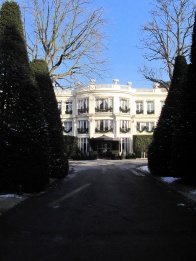


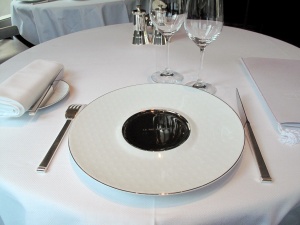

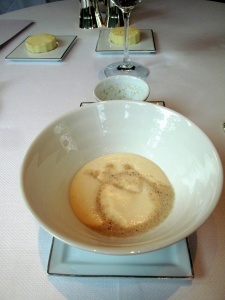








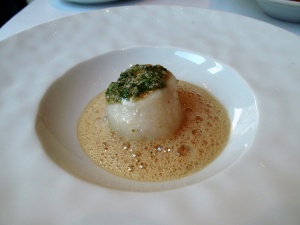








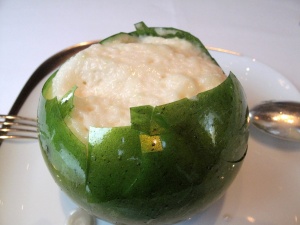

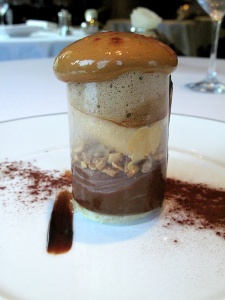


















What is the highlight of the meal? La Pomme? 😉
It seems the beauty overrides the deliciousness here. Please correct me if I get a wrong impression.
Finalement, bravooo!
Probably la Pomme, but la Café was pretty good too.
It certainly seemed that sweets were more enjoyable than savouries – considering Anton’s nature, he may be predisposed to desserts…
Unfortunately, I would agree. et Merciii!
Hi,
another excellent & absorbing review. I have a couple of questions if you don’t mind:
1. You seemed to have eaten at all these Parisian restaurants within a few days of each other. Did you ever feel on the verge of gastronomic overload?!
2. Do you have plans to review L’Arpege? I dined there last May and it was one of the most memorable meals of my life.
kind regards
Fergal
Hello Fergal,
you are too kind. Thank you.
Of course I do not mind….
1. I am surprised no else has picked up on that or asked about it at least, but no. I really did not. To be honest, I found each new restaurant so exciting and that rush kept me going. Each eas so different and a completely new discovery. However, once home, I was shattered indeed.
I should mention I have a truely abnormal, abstemious diet whereby I barely eat outside of restaurants now! And what I do eat at home consists mainly of fruit…
2. O, Fergal, you have found my Achilles’ heel – l’Arpège is my favourite restaurant and Passard my favourite chef. I was there last May (pre-Food Snob) and had the meal of my life.
Excellent review. The thought did cross my mind of how on earth you managed such a gastronimic romp – both on the waistline and the bank balance, but it looks like you coped! I’ve enjoyed this Parisian series a lot.
Hi,
Thank you for sharing all your experience with us. Iam actually planning a parisian food trip pretty soon and I am thinking if you can give me a few recommendations.
I also wonder if you went to try Guy Savoy, since I had a wonderful meal at GS in Las Vegas last year. I also notice that you almost reviewed half of the 3 stars in paris and I wonder if you have more 3 stars reviews to come since Iam enjoying a lot with your parisian reviews.
Thank You Very Much and Have A Good Day Ahead!
Lizzie: Merci beaucoup (encore).
How did I do it? Well…I am special or Spartacus or something… 🙂
Desiree: You’re welcome and I’m jealous (I know, I know I was just there, but still!).
Feel free to email me with some more information, like what sort of food you like, how many days you have, budget, etc…and I would be happy to help.
foodsnob@hotmail.co.uk
I am dying to know how you bankroll your adventures. You don’t need to tell me this. But I’ll just keep on wondering it all the same.
Finally going to make it to JR. Thursday, with my dad. Looking forward to it.
Well, if you must know, I am a celebrated three star chef and when restaurants recognise me (and they invariably do recognise me), they refuse to let me pay…
Life is hard like that.
I look forward to hearing about it. 😛
That is an amazing review. Were you to enjoy the services of an editor, you would be as good a reviewer as I have ever encountered (that is a compliment). Bravo!
Have you eaten at Robuchon’s L’Atelier recently? I would be interested in seeing what you had to say about the food there as it is similar in concept and execution to the above, and would shed some light on your sensibilities for the many of us who have eaten at L’Atelier JR.
Again, bravo…
Hello TNM,
hmm, an editor? Are you suggesting that my write-up could use a little cutting and chopping?
Still, those are very kind words and warmly appreciated.
If you give me a day, I shall reply to the remainder of your comment.
My girlfriend and I will be in Paris next week. We are staying at a friend’s apartment in the 16th. We have all our reservations made for the trip, but I would like to see this place. Would it be the type of restaurant that we could go for dessert and a bottle of champage during the day? Do they have a bar or lounge where we could sit for an hour or so?
Well, personally, I would think ‘why not?’, but that’s just me.
It would not hurt to call and ask though – they seemed awfully nice, so I am sure they would oblige you.
There are several smaller sitting rooms in the main building: http://www.flickr.com/photos/foodsnob/3320635515/in/set-72157614572270395/
Hope you enjoy your trip!